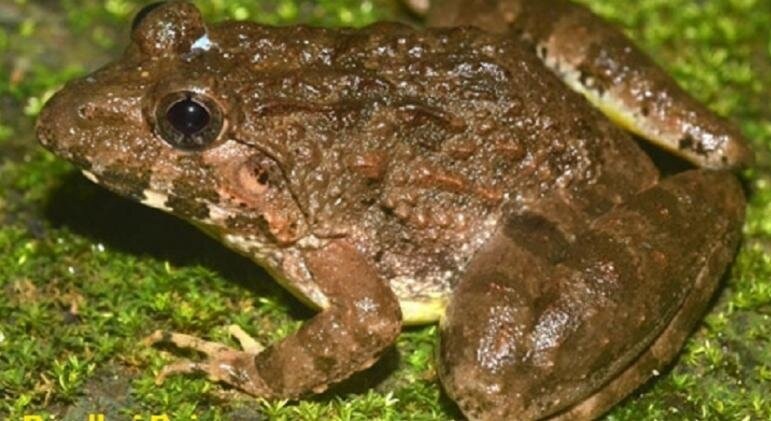Biodiversity & Environment
Morphological Phenotypic Plasticity in Kalinga Frog
- 17 Sep 2020
- 6 min read
Why in News
Recently, Indian scientists from the Zoological Survey of India, Pune have reported a first-of-its-kind discovery of morphological phenotypic plasticity (MPP) in the Kalinga cricket frog.
Key Points
- Kalinga Cricket Frog:
- Scientific Name: Fejervarya kalinga.
- It is a recently identified species which was documented in 2018.
- It was thought to be endemic only to the higher-elevation hill ranges of the Eastern Ghats in Odisha and Andhra Pradesh.
- Cricket frogs are indicators of a healthy ecosystem and live in wide habitat ranges in agricultural fields, streams, swamps and wetlands.
- Latest Findings:
- It has been reported from the central Western Ghats, with the evidence of considerable MPP.
- Its physical characteristics are entirely different from the other known Fejervaraya/Minervarya species from the Western Ghats.
- Fejervarya is a genera of frogs in the family Dicroglossidae found in Asia.
- Minervarya is a genus of frogs in the family Dicroglossidae.
- It was the only genetic analysis that helped prove that physically different-looking frogs from eastern and western ghats were the same.
- Morphological character utility (identification of structural features) is not enough to identify a species and its taxonomic (related to classification of organisms) uncertainties. Utility of genetic data and DNA barcoding tools help in resolving these.
- Morphological Phenotypic Plasticity:
- Phenotypic plasticity is the ability of an organism to change in response to stimuli or inputs from the environment.
- The term "phenotype" refers to the observable physical properties of an organism, which include the organism's appearance, development, and behavior.
- The response may or may not be adaptive, and it may involve a change in morphology (MPP), physiological state, or behavior, or some combination of these, at any level of organisation, the phenotype being all of the characteristics of an organism other than its genes.
- MPP is the ability of an organism to show drastic morphological (physical features) variations in response to natural environmental variations or stimuli.
- It is also known as phenotypic responsiveness, flexibility, and condition sensitivity.
- Frogs are known to exhibit varied reproductive behaviours by adopting different modes and strategies for successful survival.
- Phenotypic plasticity is the ability of an organism to change in response to stimuli or inputs from the environment.
- Differences in Morphological Features:
- There are contrasting morphometric differences in terms of head shape and size, fingers and toe sizes between the Kalinga frogs from eastern and western ghats.
- The Kalinga frog is a semi-aquatic frog that actively breeds in the monsoon.
- The Western Ghats are more influenced by the southwest monsoon, while the Eastern Ghats are influenced by the northeast monsoon, impacting the breeding seasons of the frogs.
- Significance of the Discovery:
- The behavioural studies of many anuran (frog or toad) species will help in generating information on the selection of breeding sites, courtship patterns and ecological adaptations.
- The information will not only help to trace the distribution of these species along the peninsular region of India but could also be used to evaluate the possible links with other species that were found in the Northeast region.
- In this era of ‘mass extinction of smaller vertebrates’ and ‘rapid climate change’ scenarios, the report is a first-of-its-kind in Indian amphibian research history.
- More Research Needed:
- The study also emphasises that there is an urgent need to address or solve problems related to taxonomic uncertainties.
- Researchers are trying to understand the possibilities of this split between two populations due to the Deccan Trap formation (volcanic/igneous region).
- Usually, such kind of habitat expansion requires more nuclear gene divergence.
- The currently found differences are not due to just a habitat expansion because there is very less genetic divergence.
- Another important question is how this little genetic divergence is leading to such contrasting morphological adaptations in these two biogeographic zones, the Western and Eastern Ghats.
- Biogeographic zones are the large distinctive units of similar ecology, biome representation, community and species.
- Also, there is a need for more research on the isolation of these two populations due to climate change.
Western and Eastern Ghats
- The Western Ghats and the Eastern Ghats are the two different biogeographic zones, with unique histories.
- While the Western Ghats are considered as a biodiversity hotspot, that is not the case with the Eastern Ghats.
- The Eastern Ghats are older than the Western Ghats and have a complex geologic history related to the assembly and breakup of the ancient supercontinent of Rodinia and the assembly of the Gondwana supercontinent.
- Both landscapes have unique ecosystems, with special microclimates and microhabitats that support a great number of diversities including amphibians.







